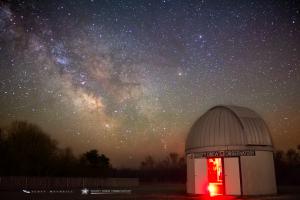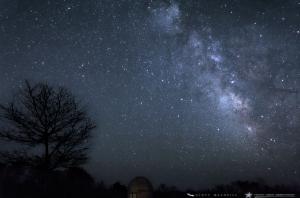
Stargazing Night - CLOSED
- Where:
- Frosty Drew Observatory
- When:
- Friday April 1, 2016 CLOSED
- Cost:
- $1 Suggested Donation per Person
Tonight is Stargazing Night at Frosty Drew Observatory and the forecast is dismal! We can expect periods of rain, clouds, and fog all night long. This forecast will leave no hope of catching observing opportunities. As a result, Frosty Drew Observatory will remain closed tonight and will return to our regular Stargazing Nights schedule on Friday, April 8, 2016.
-------------------------------------------------------------------------
Weekly Happenings
Scott MacNeill
This past week the International Space Station (ISS) has resumed passing over much of the USA, including New England. The ISS completes one orbit around Earth every 90 minutes and orbits 51.6° inclined to Earth's equator. Additionally, the only light we see during an ISS pass is sunlight reflecting off of the station, which means the ISS needs to be in sunlight while observing locations are in Earth's shadow (errr nighttime). This all limits the visibility of ISS passes over a given location. We generally see visible passes in the evening over a near three week period, where the Station is visible every night, usually more than once. Followed by a period of no visibility for a couple weeks before the ISS becomes visible for about three weeks in the morning sky during the hours before sunrise.
Sighting the ISS is a cake walk! It is super bright and commonly mistaken for an airplane. Visiting our home page will give you pass times applicable to Southern New England, though you can get pass times for any location from NASAs Spot the Station. Now all we need is somewhat clear skies. So gear up and set out each night just after sunset and catch sight of the ISS, humanity's only continuously inhabited residence in space.
Now that April is upon us, the stunning summertime Milky Way is returning to the skies over Frosty Drew Observatory resulting in our annual bombardment of Milky Way hunters and hardcore night sky photographers that descend onto the Frosty Drew campus. If you haven't done it, then you are really missing out, as the summer Milky Way at Frosty Drew is certainly a sight to see!
Unless you are part of the night sky crazies demographic, you may have wondered why the bright Milky Way is not visible during the winter when the sky appears to be so clear. Being that Earth spins on its axis (our day), stars appear to change their position over the course of the night. Because Earth orbits the Sun (our year), stars appear to change their position over the course of the year. All this spinning and orbiting causes Earth's nighttime side to orientate towards different parts of the Milky Way galaxy. During the winter months, Earth's nighttime side is orientated opposite the bright galactic center of the Milky Way and we see the dim outer edge of the galaxy and the blackness of space beyond. Though in the summer months, Earth's nighttime side is orientated towards the bright galactic center resulting in a fabulous view of the galactic center obscured by wispy dust lanes and the Scutum-Centaurus Arm, which cuts across the center from our view. Numerous arms of the Milky Way will span the sky from horizon to horizon, giving up an amazing insiders view of the galaxy that is only visible outside of the bright glow of city lights.
During April, views become strikingly visible in the early morning hours on moonless nights. Viewing the Milky Way during the early morning hours at Frosty Drew is prime! Our best sky is in the South Southeast and that is where the center of the Milky Way is most visible at this time. Additionally, the ambient glow of artificial lighting is at a minimum during the wee hours. Rise times will become earlier with each passing night, eventually keeping the Milky Way visible all night long come June.
Take as many opportunities as you can to catch a view of the Milky Way rising over Frosty Drew Observatory this spring and summer. Skies need to be clear and Moon-free before setting out as the bright moonlight will obscure most, if not all, of your view. If photography is your digs, then try your night sky chops against the Milky Way. Bring a blanket and reclining chair, lay back and let yourself get lost in a cosmic playground of billions of stars.
-Scott


